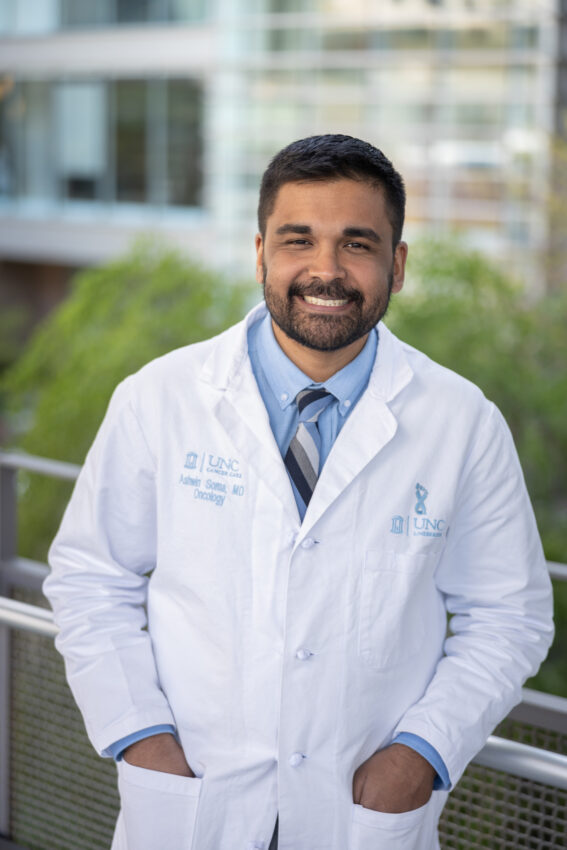
Ashwin Somasundaram, MD, has always had a passion for puzzles. Since he was young he’s enjoyed solving riddles and multidimensional math and physics problems. This interest in complex mental tests, paired with his lifelong love of science, have contributed to a successful career studying and treating cancer and led him, ultimately, to the UNC Lineberger Pancreatic Cancer Center of Excellence (PCCE).
“In my opinion, there seems to be no greater puzzle worth solving for my generation than the treatment of cancer,” says Dr. Somasundaram, who recently joined the PCCE as a medical oncologist and Assistant Professor of Medicine. We sat with Dr. Somasundaram to discuss his work in pancreatic cancer and discover how he and his team are contributing to solve one of the most difficult puzzles of our time.
You’ve returned to your hometown Chapel Hill after several years with the University of Pittsburgh. Why did you choose UNC as your next step?
I joined UNC because the Triangle is my home, and I am proud to take care of the state and the people who took care of me throughout my life. UNC Lineberger is a wonderful and supportive place, and it has always been a place full of talented researchers and collaborations. The PCCE is particularly thriving as multiple new faculty members are approaching the evaluation of pancreatic cancer in novel ways not found elsewhere.
What does a typical week in the PCCE look like for you?
My week is split in two. I spend half of my time in my clinic seeing and treating patients with pancreatic cancer and other GI cancers. This time is focused on ensuring that our patients receive the absolute best care possible and access to the most informative and innovative clinical trials across the country. A typical clinic day consists of seeing patients with my nurse navigator, Leanne Ormsby. Patients might be seen for a new diagnosis, starting or ongoing chemotherapy, looking at CT scans to make sure cancer hasn’t returned, or enrolling in clinical trials.
The remainder of the week is spent growing my research program, which is focused on the exploration of the pancreatic tumor microenvironment. This typically involves obtaining patient samples, either from our standard-of-care pipelines or from our clinical trials, and evaluating them for mechanisms of resistance to checkpoint blockade therapy. We also ensure that our methodologies cast a wide enough net to utilize the data for the entire PCCE.
How does the clinical component of your job influence the research side (and vice versa)?
The clinical and research sides speak to each other constantly through my practice, and this is one of the main benefits I have as a physician-scientist. My clinical experience allows me to ask focused, practice-changing questions and avoid being esoteric, while my research experience ensures that the trials I design and the methods I am using to answer these research questions are practical, feasible and rational.
Since you entered medical school, how has the treatment and study of pancreatic cancer evolved?
The main thing I have noticed in pancreatic cancer since I was an undergrad even is how little we know and how much there must be left to discover. Cancer immunotherapy and tumor immunology has been a large aspect of my research focus for the past five years, and yet it has no signal in pancreatic cancer. The biggest finding, which is still early, is the evaluation of KRAS inhibitors possibly having a signal in pancreatic cancer.
It’s difficult to know how clinical methods will change and research will expand, particularly regarding pancreatic cancer, which is notoriously tricky to catch in time to properly treat. But what do you predict might be the next puzzle piece?
The next piece of the puzzle in my opinion is either improving our options for targeted therapy—such as the evolution of KRAS inhibitors—or our ability to target the components of the tumor microenvironment outside of the cancer cells. This would mean modulating stromal cells to be anti-tumor or allowing for immune activation within the tumor. There needs to be a more systems approach to the evaluation of the pancreatic tumor microenvironment and not one siloed by cell type or discipline, and that systems approach is what we are trying to do at PCCE.
A systems approach—applying research insights from various disciplines to better assess clinical outcomes—is essential to the PCCE’s mission. Could you elaborate on the collaborative methods that are so necessary for advancement?
The systems approach indeed requires collaboration, and this is something I have some experience with as a physician-scientist. Some examples include working with surgeons and clinicians to obtain patient consents and adequate fresh tissue and blood, along with coordinating the clinicians and nurses with multiple basic science labs, followed by core facilities such as flow and pathology and imaging, and finally with sequencing and bioinformatics. There are a lot of moving parts that need to be in sync to achieve success. We all learn from one another in order to push for new knowledge.
Thank you for taking the time, Dr. Somasundaram. Your work is a round-the-clock pursuit, but could you share a bit about yourself outside of UNC Lineberger?
I am married to my wonderful wife, Mary Ann, who is in law enforcement. We have been happily married for nine years and have known each other since middle school, as we both attended Guy B. Phillips Middle School here in Chapel Hill. My favorite hobbies are playing board games and golfing poorly.
—Tyler Rice, UNC Lineberger Pancreatic Cancer Center of Excellence
